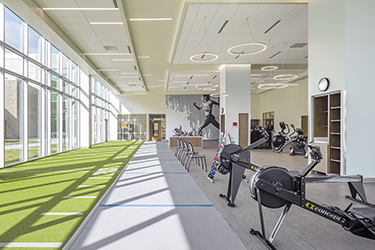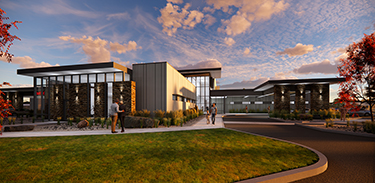|
Subscribe / Renew |
|
|
Contact Us |
|
| ► Subscribe to our Free Weekly Newsletter | |
| home | Welcome, sign in or click here to subscribe. | login |
Architecture & Engineering
| |
 |
February 29, 2024
Centering the patient and community in rural healthcare design
NAC Architecture

Farrell
|

Estejab
|
Rural healthcare is facing a crisis on multiple fronts. Recent years have exacerbated challenges and reduced rural communities’ access to quality healthcare. This means every rural healthcare project is a vital opportunity to change the direction of healthcare for these communities.
With aging facilities and a lack of amenities, rural hospitals have struggled to attract providers and staff and provide contemporary care models for patients. Rural communities are also taxed with increased fatalities in all the leading causes of death, higher infant mortality rates, teen pregnancies, and obesity and diabetes in adults and children. Frequently these communities face cultural biases and misinformation in seeking medical care. Strong cultures of self-reliance often lead patients to postpone seeking treatment until an issue has progressed from critical to emergency.
UNDERSTANDING WHERE WE START
Despite overall similarities in rural communities, each is unique and facing their own version of these challenges. Visioning and stakeholder engagement is crucial to understanding current and future needs. We have employed this process to guide design decisions at two recent projects, Quincy Valley Medical Center in Quincy, Wash., and Wayne HealthCare in Greenville, Ohio. Though these communities differ in their make-up and design execution, they are both strong indicators of a positive change in the landscape of rural health.
Quincy, like many rural communities, is primarily agrarian with a strong culture of self-reliance. The area was served by an aging facility originally built in 1959. The importance of Quincy Valley Medical Center was well-stated by the General Services Director, Newton Moats, who described Quincy as “a place where I could feel like I was doing important work, and at the same time, allowed me to raise my family, expand my career and have some amazing relationships with co-workers and community. I have stood in [these] halls and watched [the building] and our staff save life, after life, after life for decades.”
However, Quincy was built under older health models and did not lend itself to modern concerns of privacy, ergonomics, or adaptability.
Wayne HealthCare faced similar barriers with an outdated facility and an agrarian economy, in addition to an aging and diminishing population. Approximately 8.6% of its patients lack insurance, and like many rural areas, a shortage of healthcare workers caused significant staffing challenges. Their existing facility served the community for nearly 100 years, but Wayne HealthCare wanted to evolve from a hospital to a hub for community wellness.
LISTENING TO COLLABORATE
Visioning sessions combined with our analytics allowed us to push beyond generalizations of the issues facing all rural healthcare providers and pinpoint solutions that would best support these unique communities and settings.
When NAC began working with Quincy Valley Medical Center, we asked: “What do we want to create?” This led to a vision for a new hospital that would be adaptable and spacious, provide community gathering space, and incorporate nature. We held multiple visioning sessions with stakeholders, staff, caregivers, and community members.
We learned their community was willing to invest in its healthcare facility; district voters approved a $55 million bond for the new hospital. Hospital leadership was committed to being good stewards of the community investment. As sessions continued, we identified areas of concern and developed collaborative solutions with the stakeholders.
Visioning sessions and observations revealed that the existing building had visibility and wayfinding problems. The new design will give the building a clear civic presence as a hospital, and provide two distinct public entrances, for the emergency department and the main hospital. These entries will be internally connected by a central lobby that is part of the primary circulation loop.
To be inclusive for the community, including a large English as a second language population, wayfinding will include bilingual signage and color coding for each department. The new facility will also provide several spaces with varying levels of privacy in addition to the central lobby, accommodating larger extended families of patients.
Attracting new staff surfaced in our discussions as a key need. The new design will respond with amenities such as four on-call suites with private shower rooms and ample off-stage respite space with views of the new healing gardens.
PLANNING FOR GROWTH AND ATTRACTING PATIENTS
The new hospital will provide outpatient services, a new clinic, and be equipped with telehealth services, among other modern programmatic features. Analytics research into the demographics and future age cohorts of the hospital district and surrounding areas allowed us to plan for prospective growth with evidence-based data. Soft spaces are strategically placed in the design to allow programs to grow, and areas of the site are zoned for future building expansions.
The new Quincy Valley Medical Center is now under construction, due to open to its community in June of 2025.
At Wayne HealthCare, several key drivers surfaced during the visioning workshop. Wellness was one that continued to arise and ultimately drove planning, design, and operations. Because most of the impact on a person’s health happens at home, work, and in social settings, Wayne HealthCare sought ways to positively influence a person’s health beyond the walls of their facility. The project aimed to convey a welcoming image to the community.
In rural communities, reluctance to seek healthcare can stem from factors such as lack of insurance, limited health literacy, social stigma, concerns about privacy, and mistrust or fear. Recognizing this, we proposed a shift in mindset from a focus on “sick-care” to an emphasis on “well-care.”
Encouraging individuals to visit the facility for wellness activities and not solely for health emergencies allows Wayne to empower and educate the community about health issues proactively. This concept inspired the creation of a rehabilitation and wellness center on the ground floor near the new main entrance. This center, which includes a community center, education demonstration kitchen, and fitness center, places Wayne’s commitment to community health and wellness center stage.
Wayne also wanted to combat another problem in rural healthcare — higher fatalities in infant and maternal care. The aging facility struggled to attract mothers to choose Wayne HealthCare, and traveling long distances to reach newer facilities puts mothers and infants at risk. A 2023 report by Marmolejos and Silverston notes that maternity care deserts are on the rise, with 1,119 more counties lacking hospital or birth center obstetric care and providers in 2022 than 2020. In response, Wayne HealthCare’s new addition includes the “Special Beginnings” area, designed to provide state-of-the-art care close to home.
With Wayne, we can see the results of a collaborative visioning process in practice. Following the completion and occupancy of Wayne HealthCare’s new addition, the facility experienced a notable increase in its HCAHPS score, a key indicator of patient satisfaction. This improvement in the score, along with positive testimonials from both patients and staff, stands as proof of the impact a patient and community-centered facility can have in a rural healthcare setting.
Heather Farrell is a senior associate in NAC’s Spokane office and a leader in its healthcare practice with extensive rural healthcare expertise. Hamid Estejab is a design and analyst synthesizer with a focus on healthcare, data analytics, and research in NAC’s Columbus office.
Other Stories:
- The need for high-performance building enclosure design
- Designing library spaces for the children of today
- Bypassing review to boost affordability
- Seattle’s commercial development at a crossroads
- Designing for health in affordable housing
- Disrupting inequality in housing
- Trends transforming life-science building design
- Eight trends shaping design for cities in 2024
- Engineering with support from the sky
- Transforming yesterday’s spec office into the destination workplace of tomorrow
- An uncertain forecast for middle housing




